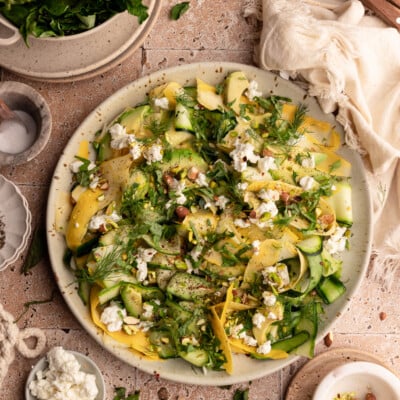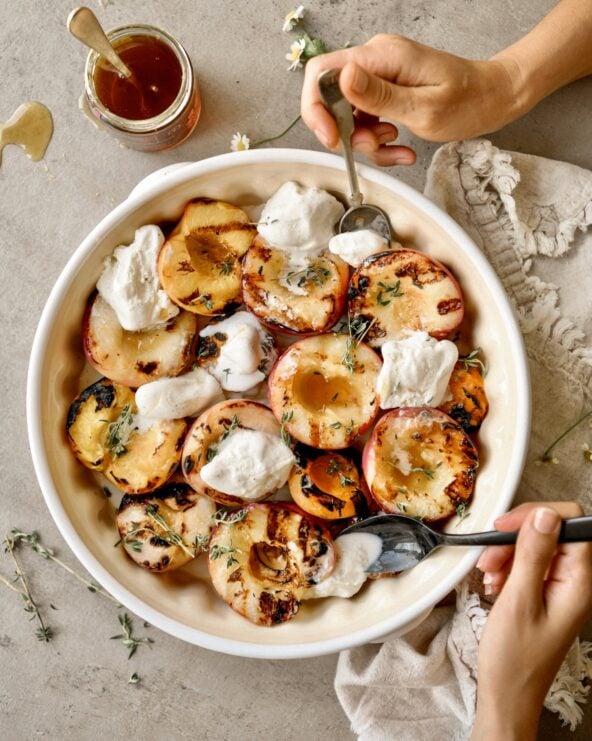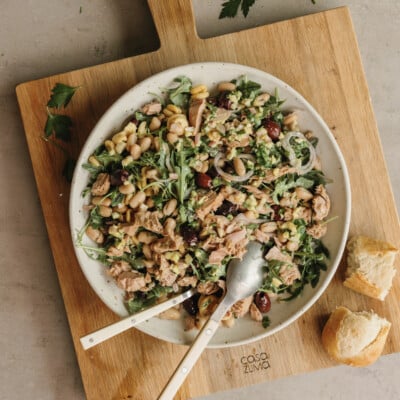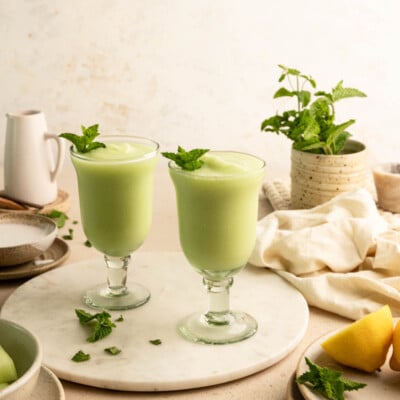What do my mom’s salmon chraimeh, Camille’s mom’s almond bread and Morgan’s mom’s chicken parm all have in common? Besides for the fact that they’re delicious beyond belief, each one is the kind of dish that can only be learned firsthand. In their cases, a written recipe in a book doesn’t compare to standing beside the cook herself and hearing her inspiration, stories, tips and tricks and eyeballed measurements associated with the dish they’ve been preparing for decades… and it’s that heirloom quality that makes the food taste rich and distinct.
With that idea of togetherness-through-food in mind, Elizabeth Winslow (you know her as the author of our Market Fresh column) recently launched Kitchen Underground. The website serves as a place where food lovers can discover one-of-a-kind cooking classes, taught by real cooks in intimate, authentic spaces. Always excited to try something new, we were thrilled when Elizabeth invited our team into her gorgeous home for a Persian cooking class, taught by Mahshad Vakili. Turns out Elizabeth knew what she was doing when she created Kitchen Underground — our lunchtime get-together was enriching, personal and inspiring, and we each left feeling full and totally enlightened. Keep reading for all the details and some must-try Persian recipes…
*photography by Thomas Winslow

Elizabeth, what inspired Kitchen Underground?
E: Some of my happiest moments in life have been cooking in the kitchen with friends. I wanted to create an opportunity for people to connect with people in their own community to learn something new and delicious and have fun cooking together. It’s also a great way to connect and hear stories from people from a wide range of backgrounds – I love learning about new ingredients and foods from far flung places and new-to-me culinary cultures.
Tell us about your amazing cookbook collection:
E: I love reading cookbooks cover to cover like novels. In every cookbook there’s a fascinating food story and I honestly feel like I’ve come to know and love all the authors of the cookbooks in my collection (now numbering over 400 – yes, I might have a little “problem”!).

How does Kitchen Underground work?
E: Visit the website, peruse the classes being offered and request a spot. You have the opportunity to view profiles of instructors before requesting a spot.
Kitchen Underground is perfect for anyone who is a little adventurous, who loves food, who is willing to be open to new things and ready to jump in the kitchen with other fun, like-minded people for a one-of-a-kind experience.

Elizabeth welcomes us with an iced version of Austin-based Nile Valley Hibiscus Mint tea, served in Moroccan tea glasses. Mahshad then kicked off the cooking class by teaching us the steps to making Kashkeh Bademjan, a popular Persian appetizer.

Mahshad, your passion for food is contagious. What is your food background?
M: I’ve been cooking since I’ve been able to reach the stove. My mom is a brilliant cook (mostly Persian food), and I was inspired by the meticulous attention she paid to every meal. I became increasingly obsessed with color, texture, flavor, and experimentation as my taste buds developed, and now I like to cook as often as my schedule permits. Sometimes it’s a new recipe or a “let’s see what’s in the pantry” dish for just me and my fiancé, Mat, and other times it’s an epic feast for 10-30 people.
I don’t discriminate when it comes to culture, but my specialties (and natural flavor instincts) definitely lean toward the Middle East and the Mediterranean. I was born in Iran, but grew up in the states, and eating with my family (immediate and our adopted “relatives” from the Iranian community in Boston) was a huge part of my life. These days, my brother and I take over on holiday gatherings, and there’s always a few Persian dishes alongside our Thanksgiving turkey or Christmas roast.

We love caramelized onions, but have never heard of long browned onions. How exactly are they prepared and used?
M: Many Persian dishes call for “piaz daagh” (literally, “hot onions”), which is basically a step beyond caramelized onions. Depending on the dish, you may need to sauté until they actually become crispy, but the sweet spot is when they are still a bit tender and oily. To some, the key to Persian cooking is good rice, good saffron, and good piaz daagh. Again, it’s a totally unpretentious thing, but it takes a long time to make, and a long time to master.
The day before this class, my mom asked me if I’d already started the piaz daagh, and if I was making them on the porch or in the house. Personally, I love the smell of cooking onions, but it can be overwhelming, especially when it takes almost an hour to make a big batch. I have memories of my mom standing in our yard in a winter coat making piaz daagh in preparation for a big dinner party (cooking for 20-30 people every other month or so was totally normal with my mom and my “aunts” in Boston).

Do you have any tips for peeling an eggplant?
M: Make sure you make plenty of slices along the body of the eggplant before you roast it (the long way). Once they’ve reached the appropriate doneness, take the eggplants out of the oven and let them cool almost completely to make peeling easier.

Score a circle along the top, just below the stem, and pull the skin off with your thumb and a paring knife. If cooked enough, it should slip right off. If you’re really pressed for time, cut the whole thing in half lengthwise and scoop out the flesh instead. Don’t be afraid to get in there and scrape it with a spoon.

What is your all-time favorite food memory?
E: How could I choose just one? On my kids’ birthdays, we always all pile in bed together to open presents and then I make chocolate chip pancakes – that would definitely be high on the list!
M: It seems like every great food moment becomes a favorite food memory, but the ones that really stand out for me usually involve cheese. On our first trip together — a train ride from NY to DC to meet some of his closest friends — my fiancé, Mat, whipped out a cutting board, a brand new oversized chef’s knife, a crusty baguette, some gorgeous tomatoes, and a tub of fresh ricotta made that day at a Brooklyn deli. Not exactly your ideal travel food. I remember him fighting with the obnoxious plastic packaging on the knife and getting a lot of concerned looks from other Amtrak passengers. He proceeded to make me individual bruschetta like bites of perfect gluteny, sweet-tart, creamy goodness, while we laughed at the mess we were making, connecting and becoming closer through this fresh, simple, and beautiful meal. We spent a lot more time chasing down perfect ricotta (and other Italian cheeses) all over NYC and Brooklyn after that, but it was a moment I’ll never forget.

Mahshad adds dried mint to the cooking onions, which can be found at most Middle Eastern specialty food stores.

While Camille continues to stir the onions, Mahshad tells us a bit about this classic Persian dish.
M: Kashkeh Bademjan is popular Persian appetizer that can be eaten warm or at room temperature with toasted pita wedges, flat bread, or over rice…

M: Bademjan is the Persian word for eggplant, and kashk is a thick white dairy product made from cultured milk and whey. It’s close to sour cream, but with a deeper umami flavor that you might find in Parmesan cheese. The dish is made with roasted eggplants, caramelized onions, herbs, spices, and kashk (and sometimes with walnuts).

M: Persian food has a lot of soul. The classic dishes can take hours (if not days) to properly prep and present, but there is nothing pretentious about it, and in some ways, it is much more like peasant food than haute cuisine. To be sure, when you walk up to a dinner spread at an Iranian person’s house, you may see meticulously arranged platters of perfectly steamed, aromatic basmati rice brushed with saffron, an array of stews (ghormehs) with delicate garnish of nuts and onions, ornamental dishes overflowing with fresh herbs, radishes, feta cheese and walnuts, and warm flat breads that will make you reconsider your relationship to toast. But once you dig in, all the colors blend together in a beautiful pile of delicious, and there’s nothing delicate about it. You eat with a spoon and fork (or use your hands and scoop food into the flatbread) — no knives on an Iranian dinner table. The fork acts as an assistant to the spoon; you’ll know you’re eating with an Iranian person if the spoon is the dominant vessel.

Mahshad then put the finishing touches on these amazing sweet meatballs:
M: The Pomegranate + Pistachio Meatballs came together as a hybrid of recipes I got from my mom, from various cookbooks and blogs, and from my own experimentation. They’re made with lamb and beef, fresh herbs, spices, and two of Iran’s most beloved exports: pistachios and pomegranate! They’re rich, sweet, a little spicy, and loaded with flavor. The best part is, you can make them a couple days in advance and pop them out for a party. Instant applause!

Click here to get the recipe for Mahshad’s Pomegranate and Pistachio Meatballs!

How does Persian cuisine differ from other Middle Eastern or Mediterranean food?
I think of Persian food as somewhere in the middle of Indian and Turkish cuisine. Like Indian food, you see a lot of rice. Basmati is traditionally from India (literally means “fragrant”), and is the choice grain for Persian rice dishes. Also, our stews (“ghormehs”) are similar to Indian “korma”, which consists of a thick sauce with braised meat (or veggies), spices, typically served over rice.
Persian food is much less spicy, though, and we seldom use curry flavors, except for some dishes that are inspired by the Indian subcontinent or Pakistan. Turkish cuisine shares a lot of common ingredients with Persian: lamb, beef, chicken, eggplants, onions, lentils, beans, and tomatoes take center stage, and the tradition of yogurt and kabobs wrapped in flatbreads is another one shared in Turkish and Persian cuisine.

Click here to get the recipe for Mahshad’s Roasted Eggplant Dip!

If you’re in the Austin area, sign up for a Persian cooking class with Mahshad this Fall by visiting Kitchen Underground, and be sure to sign up for Kitchen Underground’s e-mail list to be the first to find out about all upcoming classes!




